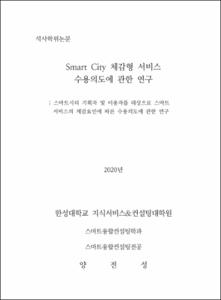Smart City 체감형 서비스 수용의도에 관한 연구
= Analysis of acceptance factors affecting the experience application services of smart city citizen
- Type
- Thesis
- Alternative Title
- 스마트시티 기획자 및 이용자를 대상으로 스마트 서비스의 체감요인에 따른 수용의도에 관한 연구
- Department
- 지식서비스&컨설팅대학원 스마트융합컨설팅학과
- Issued Date
- 2020
- Publisher
- 한성대학교 지식서비스&컨설팅대학원
- Keyword
- 스마트시티; 시민 체감형 서비스; 도시문제 해결; 서비스 수용의도; 도시기능 강화
- Appears in Collections:
- 스마트융합컨설팅학과 > 1. Thesis
- Files in This Item:
-
-
Download
 200000334347.pdf
기타 데이터 / 1.81 MB / Adobe PDF
200000334347.pdf
기타 데이터 / 1.81 MB / Adobe PDF
-
Items in Repository are protected by copyright, with all rights reserved, unless otherwise indicated.